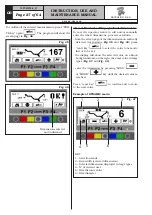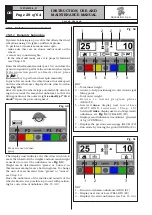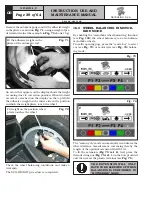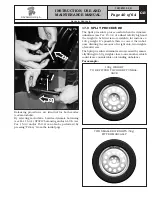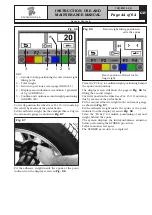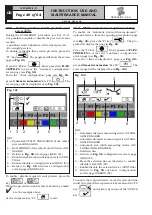
GB
Page 38 of 64
INSTRUCTION, USE AND
MAINTENANCE MANUAL
15.5 Recalculation Function
After making a spin, the wheel automatically stops,
and the required weight/s and its/their position is/are
always indicated.
If a test is performed in DYNAMIC, ALU-S, or STATIC
mode, the data of the other modes can be obtained
without making another spin by simply setting other
dimensions and pressing the “Recalculation key
”
From the results page (see for example
Fig. 50
), press
key
; the entered measurements page will be
displayed (see
Fig. 47
).
At this point, simply set the dimensions again, in ALU-
S, STATIC or again DYNAMIC mode, as explained in
par. 15.1, and press key R “
”
The screen will show a new page with weights and posi-
tion, in the new ALU-S, STATIC or DYNAMIC modes,
taking into account the new dimensions.
No new spin has to be made because the machine con-
tinues to store the data of the previous spin.
Similarly, new weight and position data can be obtained
by switching from an “Auxiliary Programs” mode (see
Par. 15.4) to another mode (ALU-S1 – ALU-S2 - STAT-
IC1 - STATIC2 - ALU1 – ALU2 – ALU3 - ALU4 – PAX)
without making another spin.
If, for example, from the page where the ALU1 results
are shown (see
Fig. 63
) key R
, is pressed, the
program displays the list of auxiliary programs (see
Par. 15.4).
At this point, select the required program by means of
the key
, if necessary set the new dimensions
and press key R “
” again to obtain the weight and
position values in the new mode, taking into account
the new dimensions.
15.6 ECO-WEIGHT procedure
After making the wheel spin in ALU-S mode, the moni-
tor shows the total of 2 adhesive weights to precisely
correct STATIC and DYNAMIC unbalance (see
Fig. 53
).
It is possible to fit a single weight at a predetermined
distance from the machine, so as to optimise the weight
consumption and reduce both the DYNAMIC and any
remaining STATIC unbalance as much as possible.
Unlike the standard STATIC procedure, the ECO-
WEIGHT procedure, though only using one weight,
also considerably reduces the DYNAMIC unbalance,
because the fitting distance of the weight on the rim
is also calculated.
From the ALU-S unbalance results page (see
Fig. 53
),
press the Eco-Weight “
” key
The page shown in
Fig. 70
will be displayed.
Fig. 70
1
4
5
6
KEY
1 – Equivalent dynamic unbalance of the inner and
outer side of the wheel
2 – Equivalent static unbalance
3 – Remaining static weight after performing the
ECO-WEIGHT program
4 – Return to initial phase (display of ALU-S values)
(RED) (F1)
5 – Displays the exact unbalance (not approximate
at >2 / >5 g) (CENTR)
6 – Performs test spin (GREEN) (F4)
2
3
G2.124R - GP2.124R
RAVAGLIOLI S.p.A.
1297-M010-0_R




